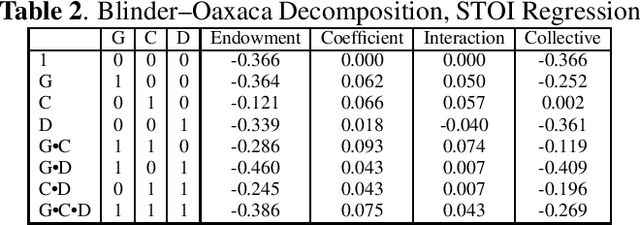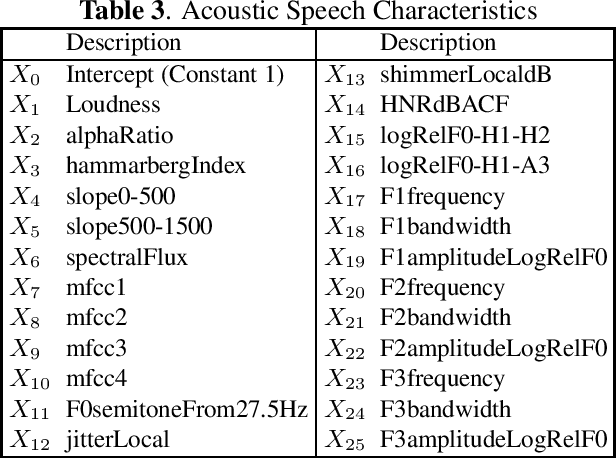Yunyang Zeng
Psychoacoustic Challenges Of Speech Enhancement On VoIP Platforms
Oct 11, 2023


Abstract:Within the ambit of VoIP (Voice over Internet Protocol) telecommunications, the complexities introduced by acoustic transformations merit rigorous analysis. This research, rooted in the exploration of proprietary sender-side denoising effects, meticulously evaluates platforms such as Google Meets and Zoom. The study draws upon the Deep Noise Suppression (DNS) 2020 dataset, ensuring a structured examination tailored to various denoising settings and receiver interfaces. A methodological novelty is introduced via the Oaxaca decomposition, traditionally an econometric tool, repurposed herein to analyze acoustic-phonetic perturbations within VoIP systems. To further ground the implications of these transformations, psychoacoustic metrics, specifically PESQ and STOI, were harnessed to furnish a comprehensive understanding of speech alterations. Cumulatively, the insights garnered underscore the intricate landscape of VoIP-influenced acoustic dynamics. In addition to the primary findings, a multitude of metrics are reported, extending the research purview. Moreover, out-of-domain benchmarking for both time and time-frequency domain speech enhancement models is included, thereby enhancing the depth and applicability of this inquiry.
Improving Perceptual Quality, Intelligibility, and Acoustics on VoIP Platforms
Mar 16, 2023Abstract:In this paper, we present a method for fine-tuning models trained on the Deep Noise Suppression (DNS) 2020 Challenge to improve their performance on Voice over Internet Protocol (VoIP) applications. Our approach involves adapting the DNS 2020 models to the specific acoustic characteristics of VoIP communications, which includes distortion and artifacts caused by compression, transmission, and platform-specific processing. To this end, we propose a multi-task learning framework for VoIP-DNS that jointly optimizes noise suppression and VoIP-specific acoustics for speech enhancement. We evaluate our approach on a diverse VoIP scenarios and show that it outperforms both industry performance and state-of-the-art methods for speech enhancement on VoIP applications. Our results demonstrate the potential of models trained on DNS-2020 to be improved and tailored to different VoIP platforms using VoIP-DNS, whose findings have important applications in areas such as speech recognition, voice assistants, and telecommunication.
PAAPLoss: A Phonetic-Aligned Acoustic Parameter Loss for Speech Enhancement
Feb 16, 2023Abstract:Despite rapid advancement in recent years, current speech enhancement models often produce speech that differs in perceptual quality from real clean speech. We propose a learning objective that formalizes differences in perceptual quality, by using domain knowledge of acoustic-phonetics. We identify temporal acoustic parameters -- such as spectral tilt, spectral flux, shimmer, etc. -- that are non-differentiable, and we develop a neural network estimator that can accurately predict their time-series values across an utterance. We also model phoneme-specific weights for each feature, as the acoustic parameters are known to show different behavior in different phonemes. We can add this criterion as an auxiliary loss to any model that produces speech, to optimize speech outputs to match the values of clean speech in these features. Experimentally we show that it improves speech enhancement workflows in both time-domain and time-frequency domain, as measured by standard evaluation metrics. We also provide an analysis of phoneme-dependent improvement on acoustic parameters, demonstrating the additional interpretability that our method provides. This analysis can suggest which features are currently the bottleneck for improvement.
TAPLoss: A Temporal Acoustic Parameter Loss for Speech Enhancement
Feb 16, 2023Abstract:Speech enhancement models have greatly progressed in recent years, but still show limits in perceptual quality of their speech outputs. We propose an objective for perceptual quality based on temporal acoustic parameters. These are fundamental speech features that play an essential role in various applications, including speaker recognition and paralinguistic analysis. We provide a differentiable estimator for four categories of low-level acoustic descriptors involving: frequency-related parameters, energy or amplitude-related parameters, spectral balance parameters, and temporal features. Unlike prior work that looks at aggregated acoustic parameters or a few categories of acoustic parameters, our temporal acoustic parameter (TAP) loss enables auxiliary optimization and improvement of many fine-grain speech characteristics in enhancement workflows. We show that adding TAPLoss as an auxiliary objective in speech enhancement produces speech with improved perceptual quality and intelligibility. We use data from the Deep Noise Suppression 2020 Challenge to demonstrate that both time-domain models and time-frequency domain models can benefit from our method.
 Add to Chrome
Add to Chrome Add to Firefox
Add to Firefox Add to Edge
Add to Edge